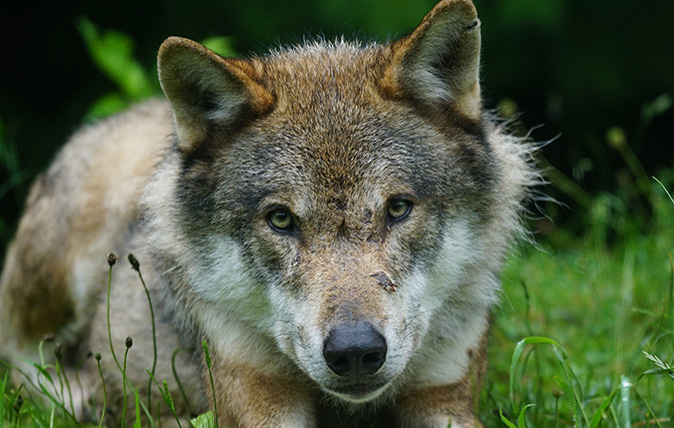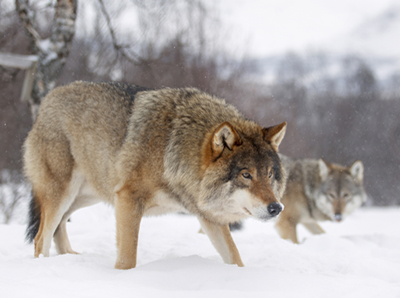Travel: Wolf tracking in Slovakia
Holly Kirkwood eschewed her normal holidays for tracking wolves and bears in the remote forests of Slovakia


Despite growing up on skis, most of my recent holidays have been run-of-the mill soggy staycations, or predictable pristine white beaches. It was time for something different, and a week tracking wolves in Slovakia seemed like a good opportunity to get back out into the snow. Having set off with an overwhelming sense of trepidation, I returned buzzing with the knowledge that I had made some small contribution to an important body of research-I was utterly hooked.
We were in Slovakia's Carpathian mountains in order to contribute towards a better understanding of the populations and habits of this fearsome predator, knowing that we were also surrounded by bears, wildcats and lynx, locating and tracking their movements in the snow. Despite being repeatedly told that we weren't on holiday-we were on expedition- and failing to come nose to nose with a wolf in the flesh, it was the best (non) holiday I've had in years.
Part of a growing trend for volunteering holidays, Biosphere Expeditions operates wildlife-conservation projects all over the world, from the Peruvian rainforest to Africa, Malaysia, and Australia. The company works with megafauna, including big and small cats, elephants, turtles, whales, sharks, wolves and marsupials to name just a few.

* Subscribe to Country Life and save up to 40%
The reason for our trip wasn't to try to see wolves and lynx (although last year's crew ran into a family of bears), but, instead, using traditional tracking methods, motion-capture cameras and modern DNA sampling, we were helping to build a body of evidence crucial to the future of the animals in their natural habitat. In Slovakia, for instance, our research into wolf population density and behaviour contributes towards adjusting the annual quota that hunters are given, and the Biosphere project in Russia has helped to enlarge protected snow-leopard habitats.
The departure point for our expedition was a frosty Bratislava in February, and a shrewd move on my part was arriving a day early and guaranteeing a good night's sleep at the Hotel Kempinski. With enormous comfortable beds and a chauffeur-driven Rolls-Royce on stand-by for guests, it's an oasis of luxury offering wonderful views of the Danube.
Our group convened on a Saturday morning at the main train station, to be met by our highly capable team leader, Adam, and, three hours later, we alighted in the wilderness of the Vel'ká Fatra National Park. My fellow expeditionaries were an eclectic mix of nationalities and personalities, ranging from a merchant seaman from Norway to two friends working for the UN in Vienna. The first evening in our comfortable mountain chalet was spent with our other team leader Peter and our resident scientist Tomas, absorbing the knowledge we'd need for our ‘holiday', including a safety briefing and animal-tracking skills.
Exquisite houses, the beauty of Nature, and how to get the most from your life, straight to your inbox.
In the morning, after familiarizing ourselves with the art of snowshoeing (the snow is far too deep for boots), GPS and animal tracks, we were declared ‘expedition ready'. The next five days were spent in the wilderness of the forest, snowshoeing and crosscounty skiing. Our daily schedule was simple: rise early and leave the house armed with a packed lunch, data sheets, map, GPS and Thermos in a backpack, and try to cover as much ground as possible in teams of four or five, logging all the relevant animal tracks we can find, and following the wolf wherever it might lead.
The forest itself is spellbinding - it's how one imagines Britain used to be 1,000 years ago: completely untamed. And snowshoeing gives you the same afterglow as a day's skiing, but with no lifts or queues, or snow machines; it feels like spending a week in a Christmas card.
Over the course of the week, we tracked foxes, deer, badgers, pine martens, wild boar, lynx, wildcats and wolves. There were red deer everywhere and, inevitably, by some mornings one or two had become dinner overnight, which only emphasised just how close we were to the predators: it's always humbling to see evidence that you're not at the top of the food chain.
Evenings were spent tucked up in our cosy house with its charming owner František, who was the perfect host, chef and chanteur. After a debrief of the day's findings, we relaxed over supper and some drinks, but eyes soon drooped after a full day in the freezing mountains, a hot supper and a glass of slivovica.
A week later, deposited back onto the main concourse in Bratislava, lungs full of mountain air and fully refreshed, each one of us swore we'd sign up for another non-holiday just as soon as we got home.
In 2014, there will be an expedition in Slovakia on February 2-15, at a cost of £1,180 per person (www.biosphere-expeditions.org). Pickups can be arranged from the airport to The Kempinski, where rooms cost from £179 (00 421 2 3223 8222; www.kempinski.com)
GreenFORCE Borneo Orangutan Rehabilitation
Help the orangutan in Indonesian Borneo. Spend six weeks working with experts to preserve the threatened population. The animals are considered a pest by locals and their habitat is threatened by deforestation.
Duration 6 weeks Cost £2,700 Start dates Spring 2014 Website www.greenforce.org Mammal conservation in Australia: quokkas, quolls and quendas
Protecting quokkas (small wallabies), quolls and quendas on the southwestern tip of Australia in the Walpole wilderness, volunteers are hands-on, trapping, radio tagging and releasing the animals to help establish the numbers and behaviour of these threatened mammals. Stay in chalets with a spa and barbecue.
Duration 1 week (volunteers can sign up for multiple slots) Cost £1,280 Start dates Jan/Feb 2014 and 2015 Website www.biosphere-expeditions.org
Biosphere Expeditions whale shark and coral programme
The Maldives government identified a need for further research and monitoring of its coral reefs and whale-shark population. Volunteers spend a week living on and diving from a 115ft boat and must be a fully qualified diver to take part. Duration One week Cost £1,740 Start dates September 2014
Website www.biosphere-expeditions.org
* Follow Country Life magazine on Twitter
